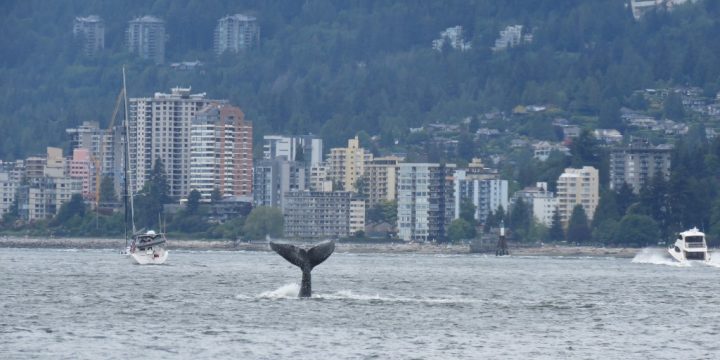A B.C. researcher is urging boaters to exercise extreme caution after a young humpback whale turned up under the Lions Gate Bridge on Friday.

Marine Education and Research Society co-founder Jackie Hildering says the whale has been identified as a one-year-old humpback nicknamed “Halfpipe” due to unique markings on its tail.
The whale had been previously sighted feeding near Bowen Island on May 11, but researchers weren’t able to identify it because its tail remained submerged.

Humpbacks do not have biosonar — the ability to use sound to map their environments — the way orcas do, making them particularly vulnerable to ship strike, Hildering said.

Get daily National news
“If they’re feeding, they are feeding and they can be oblivious of boats,” she said.
“So if there’s the notion that the whales know where (your) boat is, that is a problem. They’re usually diving long (and) can suddenly become acrobatic.”
Hildering says Halfpipe’s appearance in the inner harbour is yet another sign of the “humpback comeback” documented in recent years along B.C.’s coast.
While the population has seen a remarkable growth — growing to an estimated 18,000 animals in the North Pacific — humpbacks remain listed as a species “of special concern.”
Back in 2018, a humpback washed up dead in Tsawwassen, the victim of what the Department of Fisheries and Oceans described as “catastrophic ship strike.”
The DFO says ship strike remains the greatest threat to the animals, and that they are the most common whale reported in collisions with ships.

Hildering said about half of humpbacks have also been found to have scarring from entanglement with fishing equipment and other flotsam.
Humpbacks spend their winters breeding in Mexico and Hawaii before migrating up the Pacific coast to feed in the summer.
Humpbacks have been spotted in the waters of English Bay and near Bowen Island several times in the last four years.
Hildering said part of their resurgence in the area is due to humans no longer killing them, but she said much remains poorly understood about the animals, including the reasons behind their recent forays into inshore waters.
“It isn’t even known if we’re dealing with one, two or three populations in the waters of British Columbia,” she said.
“Even with giants that are really easy to identify as individuals, there are these fundamental mysteries and what that might be telling us about its prey and climate change.”








Comments